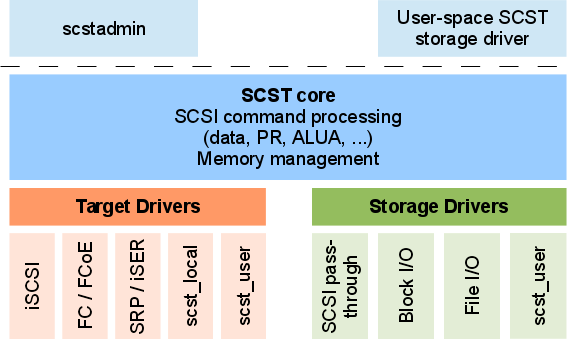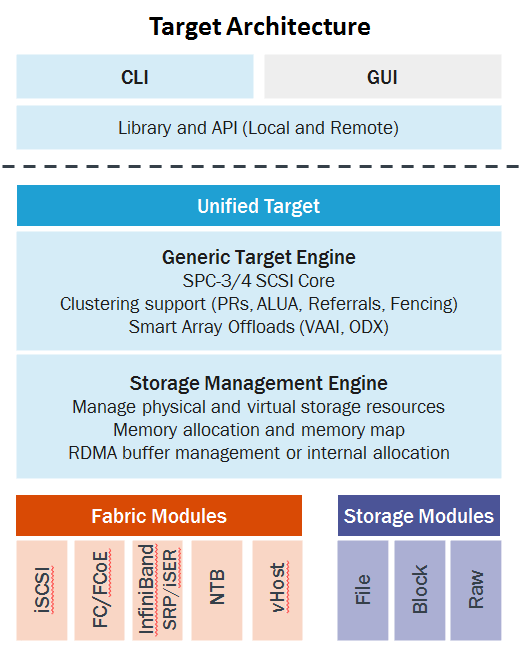|
SCST
SCST is a GPL licensed SCSI target software stack. The design goals of this software stack are high performance, high reliability, strict conformance to existing SCSI standards, being easy to extend and easy to use. SCST does not only support multiple SCSI protocols (iSCSI, FC, SRP, ...) but also supports multiple local storage interfaces (SCSI pass-through, block I/O and file I/O) and also storage drivers implemented in user-space via the scst_user driver. In order to reach maximum performance SCST has been implemented as a set of kernel drivers. SCST is often combined with RAID, data deduplication and/or high-availability cluster software to augment its functionality. The SCST software stack is the basis software of many SAN systems. Several world records have been set with SAN systems based on SCST. SCST competes with LIO Target for the same purpose of providing a generic SCSI target module inside the Linux kernel. For the narrower purpose providing a Linux iSCSI target, the ... [...More Info...] [...Related Items...] OR: [Wikipedia] [Google] [Baidu] |
SCSI RDMA Protocol
In computing the SCSI RDMA Protocol (SRP) is a protocol that allows one computer to access SCSI devices attached to another computer via remote direct memory access (RDMA).ANSI T10 SRPr16a, www.t10.org ANSI T10 SRPr16a, web.archive.org /ref> The SRP protocol is also known as the SCSI Remote Protocol. The use of RDMA makes higher throughput and lower latency possible than what is generally available through e.g. the TCP/IP communication protocol. Though the SRP protocol has been designed to use RDMA networks efficiently, it is also possible to implement the SRP protocol over networks that do not support RDMA.
|
LIO Target
In computing, Linux-IO (LIO) Target is an open-source implementation of the SCSI target that has become the standard one included in the Linux kernel. Internally, LIO does not initiate sessions, but instead provides one or more Logical Unit Number In computer storage, a logical unit number, or LUN, is a number used to identify a logical unit, which is a device addressed by the SCSI protocol or by Storage Area Network protocols that encapsulate SCSI, such as Fibre Channel or iSCSI. A LUN m ...s (LUNs), waits for SCSI commands from a SCSI initiator, and performs required input/output data transfers. LIO supports common storage fabrics, including FCoE, Fibre Channel, IEEE 1394, iSCSI, iSCSI Extensions for RDMA (iSER), SCSI RDMA Protocol (SRP) and Universal Serial Bus, USB. It is included in most Linux distributions; native support for LIO in QEMU/Kernel-based Virtual Machine, KVM, libvirt, and OpenStack makes LIO also a storage option for cloud deployments. LIO is maintained ... [...More Info...] [...Related Items...] OR: [Wikipedia] [Google] [Baidu] |
Fusion-io
Fusion-io, Inc. was a computer hardware and software systems company (acquired by SanDisk Corporation in 2014) based in Cottonwood Heights, Utah, that designed and manufactured products using flash memory technology. The Fusion was marketed for applications such as databases, virtualization, cloud computing, big data. Their product was considered around 2011 to be one of the fastest storage devices on the market. History The company was founded in December 2005 as Canvas Technologies in Nevada. Co-founders were David Flynn and Rick White. The company was based in Cottonwood Heights, Utah, near Salt Lake City. In June 2006, the company name was changed to Fusion Multisystems, Incorporated. A product with the brand name was demonstrated and announced in September 2007. In March 2008, Fusion-io raised $19 million in a series A round of funding from a group of investors led by New Enterprise Associates. David Flynn was chief technology officer, while Don Basile was chief ex ... [...More Info...] [...Related Items...] OR: [Wikipedia] [Google] [Baidu] |
ISCSI Target
Internet Small Computer Systems Interface or iSCSI ( ) is an Internet Protocol-based storage networking standard for linking data storage facilities. iSCSI provides block-level access to storage devices by carrying SCSI commands over a TCP/IP network. iSCSI facilitates data transfers over intranets and to manage storage over long distances. It can be used to transmit data over local area networks (LANs), wide area networks (WANs), or the Internet and can enable location-independent data storage and retrieval. The protocol allows clients (called ''initiators'') to send SCSI commands ( ''CDBs'') to storage devices (''targets'') on remote servers. It is a storage area network (SAN) protocol, allowing organizations to consolidate storage into storage arrays while providing clients (such as database and web servers) with the illusion of locally attached SCSI disks. It mainly competes with Fibre Channel, but unlike traditional Fibre Channel which usually requires dedicated cabling, i ... [...More Info...] [...Related Items...] OR: [Wikipedia] [Google] [Baidu] |
Fibre Channel Over Ethernet
Fibre Channel over Ethernet (FCoE) is a computer network technology that encapsulates Fibre Channel frames over Ethernet networks. This allows Fibre Channel to use 10 Gigabit Ethernet networks (or higher speeds) while preserving the Fibre Channel protocol. The specification was part of the International Committee for Information Technology Standards T11 FC-BB-5 standard published in 2009. Functionality FCoE transports Fibre Channel directly over Ethernet while being independent of the Ethernet forwarding scheme. The FCoE protocol specification replaces the FC0 and FC1 layers of the Fibre Channel stack with Ethernet. By retaining the native Fibre Channel constructs, FCoE was meant to integrate with existing Fibre Channel networks and management software. Data centers used Ethernet for TCP/IP networks and Fibre Channel for storage area networks (SANs). With FCoE, Fibre Channel becomes another network protocol running on Ethernet, alongside traditional Internet Protocol (IP) t ... [...More Info...] [...Related Items...] OR: [Wikipedia] [Google] [Baidu] |
ISCSI
Internet Small Computer Systems Interface or iSCSI ( ) is an Internet Protocol-based storage networking standard for linking data storage facilities. iSCSI provides block-level access to storage devices by carrying SCSI commands over a TCP/IP network. iSCSI facilitates data transfers over intranets and to manage storage over long distances. It can be used to transmit data over local area networks (LANs), wide area networks (WANs), or the Internet and can enable location-independent data storage and retrieval. The protocol allows clients (called ''initiators'') to send SCSI commands ( ''CDBs'') to storage devices (''targets'') on remote servers. It is a storage area network (SAN) protocol, allowing organizations to consolidate storage into storage arrays while providing clients (such as database and web servers) with the illusion of locally attached SCSI disks. It mainly competes with Fibre Channel, but unlike traditional Fibre Channel which usually requires dedicated cabling, ... [...More Info...] [...Related Items...] OR: [Wikipedia] [Google] [Baidu] |
FCoE
Fibre Channel over Ethernet (FCoE) is a computer network technology that encapsulates Fibre Channel frames over Ethernet networks. This allows Fibre Channel to use 10 Gigabit Ethernet networks (or higher speeds) while preserving the Fibre Channel protocol. The specification was part of the International Committee for Information Technology Standards T11 FC-BB-5 standard published in 2009. Functionality FCoE transports Fibre Channel directly over Ethernet while being independent of the Ethernet forwarding scheme. The FCoE protocol specification replaces the FC0 and FC1 layers of the Fibre Channel stack with Ethernet. By retaining the native Fibre Channel constructs, FCoE was meant to integrate with existing Fibre Channel networks and management software. Data centers used Ethernet for TCP/IP networks and Fibre Channel for storage area networks (SANs). With FCoE, Fibre Channel becomes another network protocol running on Ethernet, alongside traditional Internet Protocol (IP) t ... [...More Info...] [...Related Items...] OR: [Wikipedia] [Google] [Baidu] |
SanDisk
SanDisk is a brand for flash memory products, including memory cards and readers, USB flash drives, solid-state drives, and digital audio players, manufactured and marketed by Western Digital. The original company, SanDisk Corporation was acquired by Western Digital in 2016. Western Digital was the fourth-largest manufacturer of flash memory having declined from third-largest in 2014. History SanDisk was founded in 1988 by Eli Harari, Sanjay Mehrotra, and Jack Yuan, incorporated at the time as SunDisk. SanDisk co-founder Eli Harari developed the Floating Gate EEPROM which proved the practicality, reliability and endurance of semiconductor-based data storage. In 1991 SanDisk produced the first flash-based solid-state drive (SSD) in a 2.5-inch hard disk drive form factor for IBM with a 20 MB capacity priced at about $1,000. In 1992, SanDisk (then SunDisk) introduced FlashDisk, a series of memory cards made for the PCMCIA or PC card form factor, so they could be inserted int ... [...More Info...] [...Related Items...] OR: [Wikipedia] [Google] [Baidu] |
Free Software
Free software or libre software is computer software distributed under terms that allow users to run the software for any purpose as well as to study, change, and distribute it and any adapted versions. Free software is a matter of liberty, not price; all users are legally free to do what they want with their copies of a free software (including profiting from them) regardless of how much is paid to obtain the program.Selling Free Software (gnu.org) Computer programs are deemed "free" if they give end-users (not just the developer) ultimate control over the software and, subsequently, over their devices. The right to study and modify a computer program entails that |
InfiniBand
InfiniBand (IB) is a computer networking communications standard used in high-performance computing that features very high throughput and very low latency. It is used for data interconnect both among and within computers. InfiniBand is also used as either a direct or switched interconnect between servers and storage systems, as well as an interconnect between storage systems. It is designed to be scalable and uses a switched fabric network topology. By 2014, it was the most commonly used interconnect in the TOP500 list of supercomputers, until about 2016. Mellanox (acquired by Nvidia) manufactures InfiniBand host bus adapters and network switches, which are used by large computer system and database vendors in their product lines. As a computer cluster interconnect, IB competes with Ethernet, Fibre Channel, and Intel Omni-Path. The technology is promoted by the InfiniBand Trade Association. History InfiniBand originated in 1999 from the merger of two competing designs: F ... [...More Info...] [...Related Items...] OR: [Wikipedia] [Google] [Baidu] |
IBM System P
The IBM System p is a high-end line of RISC (Power)/UNIX-based servers. It was the successor of the RS/6000 line, and predecessor of the IBM Power Systems server series. History The previous RS/6000 line was originally a line of workstations and servers. The first System p server line was named the ''e''Server pSeries in 2000 as part of the e-Server branding initiative. In 2004, with the advent of the POWER5 processor, the server family was rebranded the ''e''Server p5. In 2005, following IBM's move to streamline its server and storage brands worldwide, and incorporating the "System" brand with the Systems Agenda, the family was again renamed to System p5. The System p5 now encompassed the IBM OpenPower product line. In 2007, after the introduction of the POWER6 processor models, the last rename under the System p brand dropped the p (numbered) designation. In April 2008, IBM announced a rebranding of the System p and its unification with the mid-range System i platform. The ... [...More Info...] [...Related Items...] OR: [Wikipedia] [Google] [Baidu] |
University Of New Hampshire InterOperability Laboratory
The University of New Hampshire InterOperability Laboratory (UNH-IOL) is an independent test facility that provides interoperability and standards conformance testing for networking, telecommunications, data storage, and consumer technology products. Founded in 1988, it employs approximately 25 full-time staff members and over 100 part-time undergraduate and graduate students, and counts over 150 companies as members. History The UNH-IOL began as a project of the University's Research Computing Center (RCC). In 1988 the RCC was testing Fiber Distributed Data Interface (FDDI) equipment with the intention of deploying it in its network. The RCC found that equipment from two vendors did not work together and contacted the vendors to find a solution. The two vendors cooperated with the RCC to solve the problem which was caused by differences between the draft and final FDDI specification. During this same time period the RCC was testing 10BASE-T Ethernet interfaces for another projec ... [...More Info...] [...Related Items...] OR: [Wikipedia] [Google] [Baidu] |







